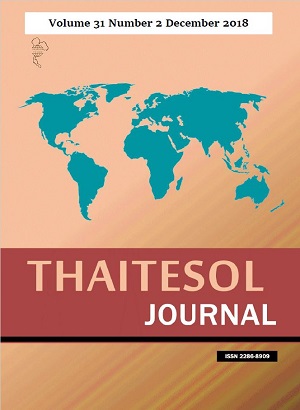INSTRUCTION GIVING IN EFL CLASSES FROM A CONVERSATION ANALYSIS APPROACH: A CASE STUDY
Main Article Content
Abstract
This research is embedded in the context of tertiary education in Vietnam where the instruction giving stage is assessed. Drawing on a Conversation Analysis perspective, the study aims to reveal teachers’ instructional patterns in three EFL classes of freshmen, thus not only maximizing the interactional structures that can enhance classroom communication but also minimizing the problems that can hinder teacher-student exchange. The findings show that two main instructional styles that can be classified from the inspected discourse namely, interactive instruction containing students’ contribution and monologue-type instruction with little learners’ involvement. Positive and negative aspects implied from the instruction giving phase that impact on classroom language are also enumerated prior to suggesting implications for educators to implement.
Article Details
Materials in THAITESOL JOURNAL may be photocopied for educational purposes. Under no circumstances may any part of this journal be photocopied for commercial purposes.
References
Barraja-Rohan, A. (2011). Using conversation analysis in the second language classroom to teach interactional competence. Language Teaching Research, 15(4), 479-507.
Button, G. & Lee, J.R.E. (1987). Talk and social organization. Clevedon: Multilingual Matters.
Cheng, T. (2016). Conversation analysis and second language interaction. Hitotsubashi Journal of Arts and Sciences, 57(1), 29-40.
Enyi, A.U. (2015). Language and interactional discourse: Deconstructing the talk- generating machinery in natural conversation. Advances in Language and Literary Studies, 6(4), 171-178.
Freeman, D., Katz, A., Gomez, G., & Burns, A. (2015). English for teaching: Rethinking teacher proficiency in the classroom. ELT Journal, 69(2), 129–39.
Le, V.C. & Renandya, W.A (2017). Teachers’ English proficiency and classroom language use: A conversation analysis study. RELC Journal, 48(1) 67–81.
Liddicoat, A. J. (2007). An introduction to conversation analysis. London: Continuum.
Markee, N. (2000). Conversation analysis. Mahwah, New Jersey: Erlbaum.
Markee, N. & Kasper, G. (2004). Classroom talks: An introduction. The Modern Language Journal, 88(6), 491-500.
Margaretha, E. (2015). Teacher’s problems in giving instruction for elementary students of Bethany School. Unpublished thesis. Satya Wacana Christian Univeristy, Indonesia.
Masats, D. (2017). Conversation analysis at the service of research in the field of second language acquisition (CA-for-SLA). In E. Moore & M. Dooly (Eds.), Qualitative approaches to research on plurilingual education (pp. 321-347). France: Research-publishing.net.
Meng, X. & Wang, X. (2011). Action study of teacher’s language on EFL classroom interaction. Theory and Practice Language Studies, 1(1), 98-104
Proctor, S. (2014). The classroom. ProELT Aptis Training Course. Kuala Lumpur, Malaysia: Ministry of Education.
Satar, H.M. & Wigham, C.R. (2017). Multimodal instruction-giving practices in web conferencing supported language teaching. System, 70, 63-80.
Scrivener, J. (2011). Learning teaching: The essential guide to English language teaching (3rd ed.). Oxford: Macmillan Education.
Scrivener, J. (2012). Classroom management techniques. Cambridge: Cambridge University Press.
Seedhouse, P. (2004). The interactional architecture of the second language classroom: A conversational analysis perspective. Oxford: Blackwell.
Sowell, J. (2017). Good instruction-giving in the second-language classroom. English Teaching Forum, 55(3), 10-19.
Tran, H.Q., (2016). Responsive turns in L2 discussion tasks: A conversation analysis perspective, Language Education in Asia, 7 (2), 100-113
Woodberry, R. D., and Aldrich, H. E. (2000). Planning and running effective classroom-based exercises. Teaching Sociology, 28 (3), 241–248.
Xiao, L. (2014). Investigating the communicativeness of classroom teacher-student interaction from a Conversation Analysis perspective. Proceedings of ClaSIC 2014, 548-581.


